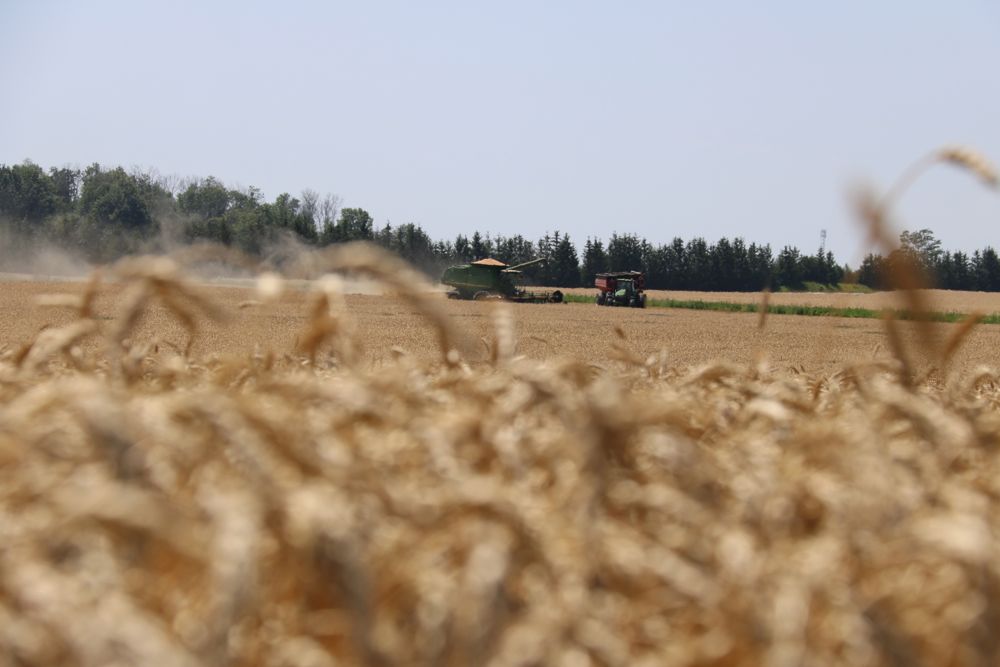Despite last year’s tough spring and the midsummer drought, Ontario soybean growers produced 109 million bushels in 2011 on approximately 2.4 million acres. A decade earlier, in another year with tough weather, we produced a scant 47 million.
Clearly, the romance between Eastern Canada’s farmers and the soybean is getting warmer and warmer, so it’s a good thing for our growers that the world has an insatiable appetite for protein, and that soybeans continue to be the oilseed of choice for the consuming world.
Both those factors augur well for soybeans in 2012, although they are counter-balanced by growing carry-overs this year.
Read Also

Could crop sharing be a viable option for your farm?
Crop sharing could be a good option for young and beginning farmers.
Being the oilseed of choice for a hungry world is a very big deal. Yes, in Western Canada, another oilseed — canola — is a very important part of the agricultural economy, and yes, canola does get traded at a premium to soybeans, with this premium sometimes reaching toward $100 per tonne before soybeans get substituted for the canola.
Still, soybeans are the world’s first choice for vegetable oil, and the demand for vegetable oil continues to grow. Burgeoning economies such as China’s have a seemingly insatiable hunger for oil. Basically these countries are turning into buyers for whatever soybeans we can produce.
So here’s what makes life interesting. Despite the good news above, soybeans are still a second choice — and sometimes even lower than that — for many Ontario and U.S. corn belt farmers. In plain language, they’d rather plant corn.
Corn genetics are improving faster than soybeans. In Ontario, provincial soybean and corn trials show a 0.32-bushel-per-acre-per-year increase in soybean yield, compared to a 2.0-bushel-per-acre-per-year increase in corn yields. So, in many ways, growing soybeans over corn is a leap of faith. (See Falling Behind, page 40.)
There are even some observers who argue that South America is better suited to grow soybeans, while North America may be better suited to grow corn. They may be right. At the very least, with South America currently producing 50 to 60 per cent of the world’s soybeans versus 10 per cent of its corn, it’s an argument that is gaining traction.
Still, the world’s appetite for protein is strong. Elaine Kub, grain merchandiser and analyst with the ARC Group of Lincoln, Nebraska says world demand for calories is growing even faster than global population. Simply put, people want better diets, meaning they want more meat, and more differentiated food products.
World demand for feed grains is growing with that meat demand, and this is also good for global demand of soybean-based protein feeds. For Canadian soybean producers, consumption trends are also good because of growth in Asian tofu and similar markets.
This was brought home to me in a very personal way some years ago when I met with an Ontario soybean buyer in Singapore. Before I had gotten on the plane to meet him, I had loaded Ontario soybeans from my bins which were destined for Asia. When I met the buyer, he told me that he had eaten soybeans for breakfast that morning, as he always did, and he explained to me how much demand that represents. For an answer, though, he didn’t give me a number. Instead, he pointed out over the city of Singapore, and over the masses of people thronging its streets.
From that point forward, I understood, and while that meeting took place 18 years ago, demand has consistently grown ever since.
World production for soybeans now stands at 257 million metric tonnes (mmt). The U.S. produces 83.2 mmt, with its competitors producing 173.8 mmt more.
Not long ago, the U.S. produced well over half of world soybeans. Now, in 2011-12, Brazil is set to produce 75 mmt and Argentina 50.5 mmt.
For the sake of perspective, it’s important to note that Ontario produces 2.96 mmt. We just are not a big player on the world stage. Despite that, however, we are still very competitive in the markets we serve and there is no reason why that cannot be enhanced.
USDA reports serve as a litmus test for futures price movement. The 2012 January USDA supply-and-demand report pegged U.S. soybean production last year at 3.056 billion bushels, up from the December figure but down 273 million bushels from last year. U.S. exports were estimated at 1.275 billion, which is down 226 million bushels from last year.
This is a significant decline from last year and reflects not only the drop in production but also the strength in the U.S. dollar that has made American soybeans more expensive on the world stage.
Ending stocks for soybeans in the 2011-12 crop year were forecast at 275 million bushels, up from 215 million last year. This actually raised the stocks-to-use ratio to 9.1 per cent. Although this is still considered bullish, it is certainly much more comfortable than last year.
The average price projected by the USDA based on their projections in January was US$11.70 per bushel.
Unlike the corn market, which is dominated by the United States, South America is increasingly the dominant factor in the soybean complex. In January and February of 2012, the South American soybean crop is maturing and moving rapidly toward harvest in Brazilian and Argentinian fields. South American weather during this critical time is exceedingly important in determining the supply that will end up on world markets. This will also have a large bearing on futures and on cash prices leading up to the spring planting season of corn and soybeans in the United States and Canada.
Soybean prices will surely be affected by South American production in 2012. But they will also be impacted by the division of acres planted in the spring of 2012 in North America. Corn stocks are still tight. In fact, the corn stocks-to-use ratio at 6.7 per cent is the lowest since 1995-96.
As well, because of ethanol, corn demand continues to build globally, so in 2012 we should expect a larger increase in corn acres in the U.S., possibly up to 94 million, which will need to come from somewhere, most likely soybean acres.
A significant decrease in soybean acres in the United States will surely affect prices moving forward. Soybeans are not nearly as bullish as corn. However, with early 2012 South American weather being very dry, soybean stocks may be compromised further in the lead-up to planting in North America. Price movement coming out of that may be very significant.
The January 2012 USDA report increased soybean production slightly for the 2011-12 crop year. Soybean prices fell on the news, but mainly followed corn on the way down. From August of 2011 until the middle of January 2012, soybean futures had actually lost $3 a bushel.
This was largely due to the non-agricultural investors leaving agricultural commodities and going into U.S. government securities, which boosts the U.S. dollar.
These increased soybean yields in 2011 are now showing up in the soybean market through more bearish soybean futures spreads in deferred months. Darin Newsom, senior grain analyst for Telvent DTN in Omaha says the commercial side of the market is growing more bearish. As a result, the deferred futures months are strengthening, reflecting less demand coming from the commercial side of the market. In other words, commercial end-users are satisfied now with supply and at the present time are not willing to pay more to get old soybeans out of farmers’ bins.
Soybean prices in 2012 will surely be impacted by currency manipulations. The elephant in the room is the U.S. dollar, which has been benefiting from speculative capital moving into U.S. treasuries, boosting the U.S. dollar.
This is negative for soybean futures prices, making them more expensive on the world stage. At the same time, the Canadian dollar tends to move in an inverse relationship with the U.S. dollar. As the U.S. dollar moves up, the value of the Canadian dollar generally moves down — which is a positive for Canadian cash soybean prices.
Even so, the Canadian soybean basis is especially sensitive to currency moves so this will need careful watching.
Ontario soybean acreage in 2012 is in flux. Corn acreage is poised to climb beyond two million acres this spring. Winter wheat acreage is approximately 700,000 acres, so in 2012, soybeans will need to compete with corn to maintain acreage.
For 2012, Canadian soybean producers need to measure all of the factors affecting the soybean complex, and to watch our production costs. The world loves its soybeans, but growing them profitably is always a challenge. CG














